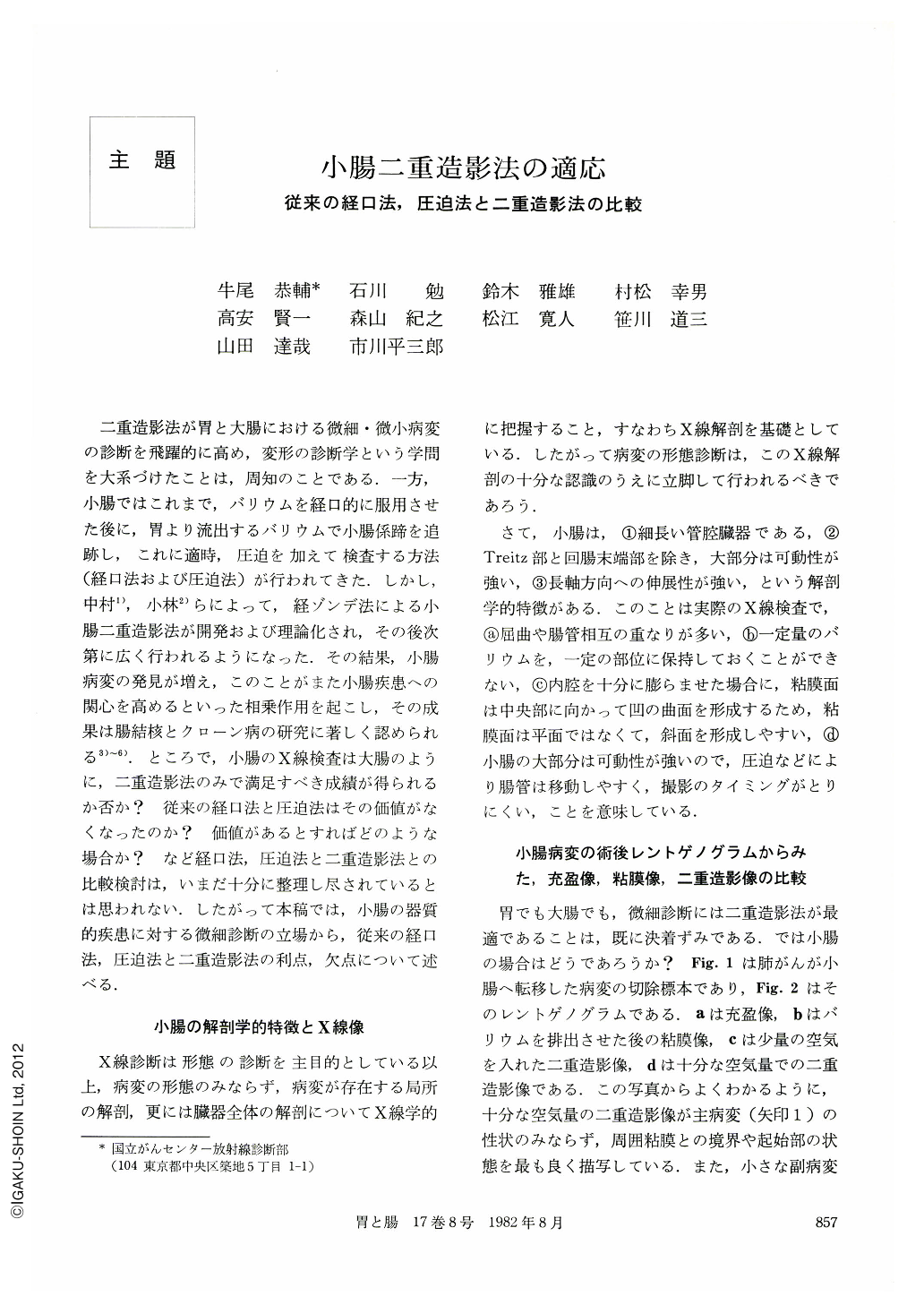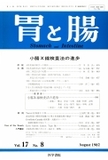Japanese
English
- 有料閲覧
- Abstract 文献概要
- 1ページ目 Look Inside
二重造影法が胃と大腸における微細・微小病変の診断を飛躍的に高め,変形の診断学という学問を大系づけたことは,周知のことである.一方,小腸ではこれまで,バリウムを経口的に服用させた後に,胃より流出するバリウムで小腸係蹄を追跡し,これに適時,圧迫を加えて検査する方法(経口法および圧迫法)が行われてきた.しかし,中村1),小林2)らによって,経ゾンデ法による小腸二重造影法が開発および理論化され,その後次第に広く行われるようになった.その結果,小腸病変の発見が増え,このことがまた小腸疾患への関心を高めるといった相乗作用を起こし,その成果は腸結核とクローン病の研究に著しく認められる3)-6).ところで,小腸のX線検査は大腸のように,二重造影法のみで満足すべき成績が得られるか否か?従来の経口法と圧迫法はその価値がなくなったのか?価値があるとすればどのような場合か?など経口法,圧迫法と二重造影法との比較検討は,いまだ十分に整理し尽されているとは思われない.したがって本稿では,小腸の器質的疾患に対する微細診断の立場から,従来の経口法,圧迫法と二重造影法の利点,欠点について述べる.
小腸の解剖学的特徴とX線像
X線診断は形態の診断を主目的としている以上,病変の形態のみならず,病変が存在する局所の解剖,更には臓器全体の解剖についてX線学的に把握すること,すなわちX線解剖を基礎としている.したがって病変の形態診断は,このX線解剖の十分な認識のうえに立脚して行われるべきであろう.
X-ray examination of the organic diseases of the small bowel has been compared and studied from three aspects: peroral method hitherto employed, compression and double contrast method.
1. Detailed diagnosis is made possible when peroral method hitherto used is combined with adequate compression.
2. The capability of the examination for delineating minute lesions is almost the same for compression and double contrast study. Lesions 1 to 2 mm in diameter can be depicted.
3. Generally speaking, lesions are apt to be delineated in a more emphasized manner by compression study as compared with double contrast method. More accurate diagnosis of a protruded lesion can be made by compression study.
4. The effective area of minute diagnosis by compression can be regarded as a radius of 3 cm. Double contrast method, on the other hand, can demonstrate minute lesions in the wide caliber portion of the small intestine.
5. Even in the double contrast study of the small intestine, a concept of routine and preferential detailed examination should be introduced. In the stage of preferential examination, double contrast study should be applied according to the portion of the small bowel. For instance, when the upper to middle segment of the ileum is examined, double contrast study with the air sent in from both sides (through the sonde and peroral) is effective. For lesions in the lower segment or terminal part of the ileum double contrast study by retrograde barium enema is most effective.
6. For diagnosis of intestinal distortion, flexion, configuration, reduced expansibility, straightening, rigidity and irregularity, double contrast study is of great use especially in inflammatory disease. Other methods are of no avail.
7. To separate and stretch overlapping or twisting of the small bowel “compressive bowel separating method” should be employed.
8. For minute delineation and diagnosis by double contrast method, it is most effective when contrast medium is intentionally coated as a thin layer to the lesion and around it.
The overall conclusion of our present study is that double contrast method is superior to other methods both in routine examination and detailed investigation. Therefore, in patients with suspicious organic lesions of the small bowel, we should perform actively the double contrast study of the small intestine.

Copyright © 1982, Igaku-Shoin Ltd. All rights reserved.


